Lateral Performance of Composite Wall with Cold-Formed Thin-Walled Steel–Concrete Sandwich Panel
Abstract
1. Introduction
2. Materials and Methods
2.1. Experimental Design
2.2. Material Mechanical Property
2.3. Loading Regime and Displacement Gauge Layout
2.4. Experimental Program
2.4.1. Main Phenomena and Characteristics of Specimen W1
2.4.2. Main Phenomena and Characteristics of Specimen W2
3. Test Results and Analysis
3.1. Load-Displacement Curve
3.2. Skeleton Curves
3.3. Stiffness Degradation
3.4. Evaluation and Analysis of Energy Dissipation
4. Finite Element Analysis
4.1. Finite Element Modeling
4.2. Validation of Finite Element Model
4.3. Analysis of Factors Influencing Shear Resistance
4.3.1. Diagonal Brace Yield Strength
4.3.2. Thickness of Diagonal Bracing
4.3.3. Arrangement Pattern of the Wall Panels
4.3.4. Dimensions of Wall Panels
4.3.5. Strength of the Connections of the L-Shaped Connector and the Flat Connector
5. Conclusions
- Two full-scale specimens were exposed to cyclic loading. According to experimental analysis, significant displacements occurred at the junctions of the upper and lower wall panels of both specimens. Furthermore, severe deformations and damage were observed at the joints around the perimeter of the wall panels.
- Compared to specimen W2, specimen W1 exhibited significantly higher values for yield load, peak load, ultimate load, and energy dissipation coefficient. However, the yield displacement and peak displacement were notably lower for W1, indicating that the arrangement of concrete core wall panels has a significant impact on shear resistance. The ductility coefficients of specimens W1 and W2 were 1.82 and 1.49, respectively, indicating good ductility performance. Additionally, within the specified displacement limits, the walls did not exhibit any damage, making them suitable for use as structural walls.
- The shear capacity of specimens W1 and W2 mainly relies on the friction, compression among the upper and lower wall panels, and deformation of flat connectors and L-shaped connectors. Therefore, it is recommended that the vertical length of the panels be shortened and the number of vertical panels increased to enhance the lateral load capacity of the composite wall.
- Parameter analysis indicates that increasing the yield strength of the diagonal braces or the thickness of the diagonal braces, enhancing the strength of connection of the flat connectors and L-shaped connectors, appropriately altering the arrangement of the wall panels, or reducing the size of the wall panels can all improve the shear bearing capacity of the composite wall. The panel arrangement of the W1-A2 model in Section 4.3.3 demonstrated the best performance throughout the entire study. It is recommended to use this type of wall configuration for further research. The panel arrangement of the W1-A2 model demonstrated the best performance throughout the entire study. It is recommended to use this type of wall configuration for further research.
- The insulation wall panels used in this experiment are designed for light steel systems; their application in other structural systems requires further investigation. The dimensions of the insulation wall panels used in this experiment are fixed. To investigate the lateral performance of the specimens, varying the dimensions of the insulation panels could be explored. Additionally, the limited number of components in this study may have resulted in deviations from real-world conditions. Therefore, increasing the number of components is recommended to reduce experimental errors and enhance the rigor of the study.
Author Contributions
Funding
Data Availability Statement
Conflicts of Interest
References
- Tarpy, T.S.; Hauenstein, S.F. Effect of Construction Details on Shear Resistance of Steel-Stud Wall Panels; AISI: Washington, DC, USA, 1978; pp. 1201–1412. [Google Scholar]
- Serrette, R.L.; Encalada, J.; Juadines, M.; Nguyen, H. Static racking behavior of plywood, OSB, gypsum, and fiberbond walls with metal framing. J. Struct. Eng. 1997, 123, 1079–1086. [Google Scholar] [CrossRef]
- Serrette, R.L.; Ogunfunmi, K. Shear resistance of gypsum-sheathed light-gauge steel stud walls. J. Struct. Eng. 1996, 122, 383–389. [Google Scholar] [CrossRef]
- Tian, Y.S.; Wang, J.; Lu, T.J. Racking strength and stiffness of cold-formed steel wall frames. J. Constr. Steel Res. 2004, 60, 1069–1093. [Google Scholar] [CrossRef]
- Fiorino, L.; Della Corte, G.; Landolfo, R. Experimental tests on typical screw connections for cold-formed steel housing. J. Eng. Struct. 2007, 29, 1761–1773. [Google Scholar] [CrossRef]
- Cheng, Y. Shear resistance of cold-formed steel framed shear walls with 0.686 mm, 0.762 mm, and 0.838 mm steel sheet sheathing. J. Eng. Struct. 2010, 32, 1522–1529. [Google Scholar]
- Mohebbi, S.; Mirghaderi, R.; Farahbod, F.; Sabbagh, A.B. Experimental work on single and double-sided steel sheathed cold-formed steel shear walls for seismic actions. J. Thin-Walled Struct. 2015, 91, 50–62. [Google Scholar] [CrossRef]
- DaBreo, J.; Balh, N.; Ong-Tone, C.; Rogers, C.A. Steel sheathed cold-formed steel framed shear walls subjected to lateral and gravity loading. J. Thin-Walled Struct. 2014, 74, 232–245. [Google Scholar] [CrossRef]
- Javaheri-Tafti, M.R.; Ronagh, H.R.; Behnamfar, F.; Memarzadeh, P. An experimental investigation on the seismic behavior of cold-formed steel walls sheathed by thin steel plates. J. Thin-Walled Struct. 2014, 80, 66–79. [Google Scholar] [CrossRef]
- Cheng, Y.; Chen, Y.J. Detailing recommendations for 1.83 m wide cold-formed steel shear walls with steel sheathing. J. Constr. Steel Res. 2011, 67, 93–101. [Google Scholar]
- Zeynalian, M.; Ronagh, H.R. Seismic performance of cold formed steel walls sheathed by fibre-cement board panels. J. Constr. Steel Res. 2015, 107, 1–11. [Google Scholar] [CrossRef]
- Gao, W.C.; Xiao, Y. Seismic behavior of cold-formed steel frame shear walls sheathed with ply-bamboo panels. J. Constr. Steel Res. 2017, 132, 217–229. [Google Scholar] [CrossRef]
- Macillo, V.; Fiorino, L.; Landolfo, R. Seismic response of CFS shear walls sheathed with nailed gypsum panels: Experimental tests. J. Thin-Walled Struct. 2017, 122, 359–370. [Google Scholar] [CrossRef]
- Wu, H.; Chao, S.; Zhou, T.; Liu, X. Cold-formed steel framing walls with infilled lightweight FGD gypsum Part I: Cyclic loading tests. J. Thin-Walled Struct. 2018, 132, 759–770. [Google Scholar] [CrossRef]
- Wu, H.; Chao, S.; Zhou, T.; Liu, X. Cold-formed steel framing walls with infilled lightweight FGD gypsum Part II: Axial compression tests. J. Thin-Walled Struct. 2018, 132, 771–782. [Google Scholar] [CrossRef]
- Zhang, Z.N.; Qian, H.K.; Wang, C.G.; Zhang, M.; Yang, Z.Y. Study on Shear Performance of Cold-Formed Thin-Walled Steel Composite Walls with Embedded Honeycomb Core. J. Archit. Struct. 2023, 44, 282–292. [Google Scholar]
- Wang, L.P.; Wu, X.Y.; Hu, M.; Liu, J.; Ding, J.X. Analysis of Lateral Resistance Performance of Novel Prefabricated Cold-Formed Thin-Walled Steel Walls. J. Southeast Univ. 2024, 54, 135–141. [Google Scholar]
- Almasabha, G.; Chao, S.H.A. New Reinforcing Configuration for Achieving High-Ductility and High-Strength Rectangular Squat Structural Walls. ACI Struct. J. 2023, 120, 235. [Google Scholar]
- Chao, S.H.; Almasabha, G.; Price, B.; Jiansinlapadamrong, C. A horizontal stiffener detailing for shear links at the link-to-column connection in eccentrically braced frames. J. Struct. Eng. 2023, 149, 04023114. [Google Scholar] [CrossRef]
- Chen, M.T.; Zuo, W.; Young, B. Tests of cold-formed steel T-joints with semi-oval hollow section chord. J. Struct. Eng. 2023, 149, 04023099. [Google Scholar] [CrossRef]
- Liu, R.; Jiang, L.; Ye, J.; Yang, H.; Hu, Y.; Han, H. Buckling behavior and failure mechanism of cold-formed steel built-up special shape cross-section columns. Eng. Fail. Anal. 2024, 165, 108716. [Google Scholar] [CrossRef]
- Dai, Y.; Roy, K.; Fang, Z.; Chen, B.; Raftery, G.M.; Lim, J.B. Buckling resistance of axially loaded cold-formed steel built-up stiffened box sections through experimental testing and finite element analysis. Eng. Struct. 2024, 302, 117379. [Google Scholar] [CrossRef]
- GB/T 228.1-2010; Metallic Materials-Tensile Testing-Part 1: Method of Test at Room Temperature. China Standards Press: Beijing, China, 2010. (In Chinese)
- GBT/50081-2019; Standard for Test Methods of Concrete Physical Mechanics. China Construction Industry Press: Beijing, China, 2019. (In Chinese)
- JGJ 227-2011; Technical Specification for Low-Rise Cold-Formed Thin-Walled Steel Building. China Construction Industry Press: Beijing, China, 2011. (In Chinese)
- Chen, W.; Hao, H.; Hughes, D.; Shi, Y.; Cui, J.; Li, Z.X. Static and dynamic mechanical properties of expanded polystyrene. Mater. Des. 2015, 69, 170–180. [Google Scholar] [CrossRef]
- JPJ 101-2015; Specification for Seismic Test of Buildings. China Construction Industry Press: Beijing, China, 2015. (In Chinese)
- Ye, J.; Feng, R. Behavior of cold-formed steel wall stud with sheathing subjected to compression. J. Constr. Steel Res. 2016, 116, 79–91. [Google Scholar] [CrossRef]
- Li, Z. Experimental Study on Seismic Behavior of Light Steel Keel-Strawboard Composite Walls. Master’s Thesis, Chongqing University, Chongqing, China, 2022. [Google Scholar]
- Hu, J.X. Study on Seismic Behavior of Cold-Formed and Thin-Walled Steel Composite Wall with Diagonal Bracing. Master’s Thesis, Chongqing University, Chongqing, China, 2018. [Google Scholar]
- GB 50010-2010; Code for Design of Concrete Structures. China Construction Industry Press: Beijing, China, 2010. (In Chinese)
- Xiao, T.P. Seismic Behavior of Lightweight Steel and EPS Concrete Shear Walls. Master’s Thesis, Southwest University of Science and Technology, Mianyang, China, 2023. [Google Scholar]
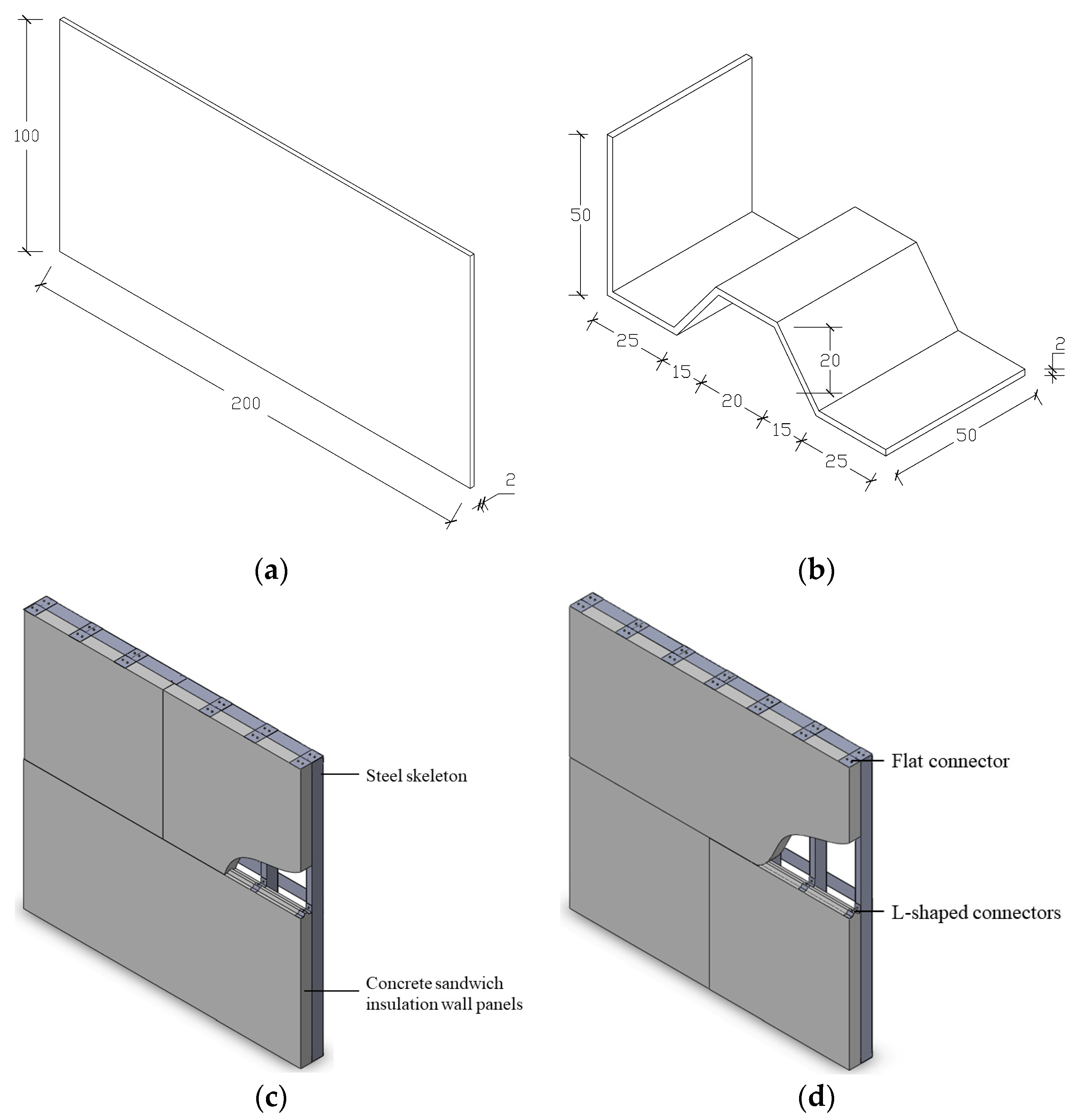




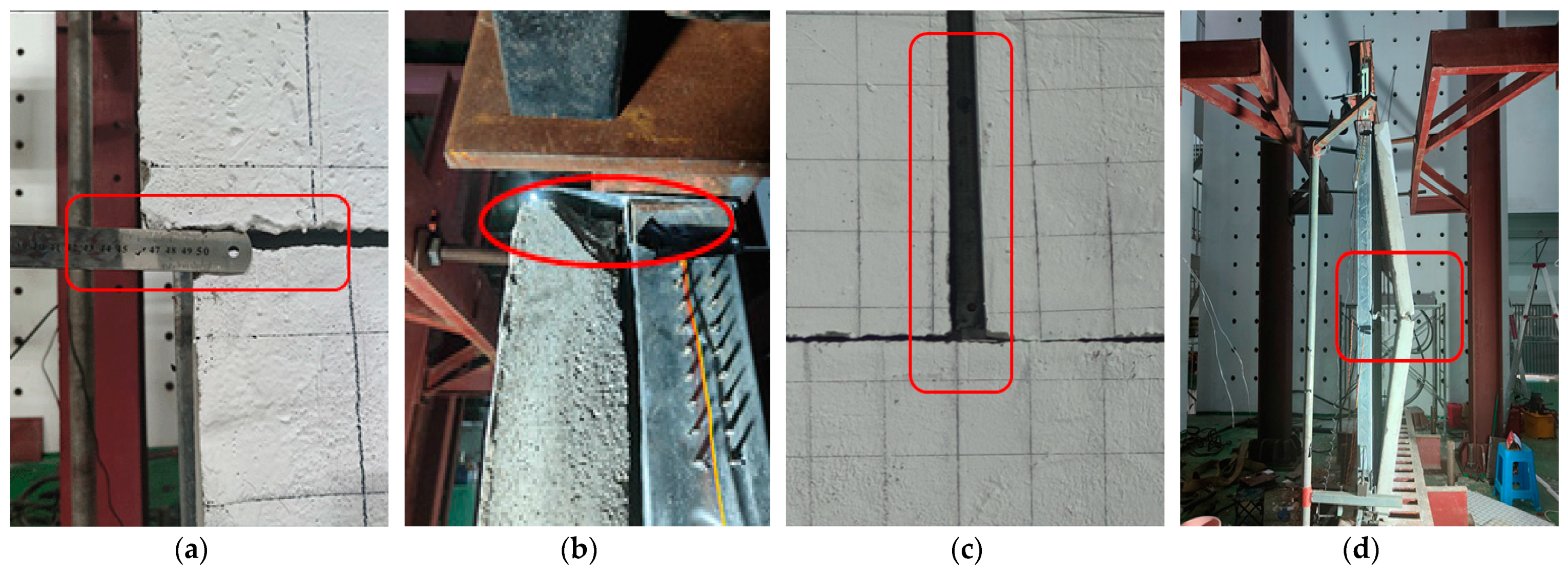
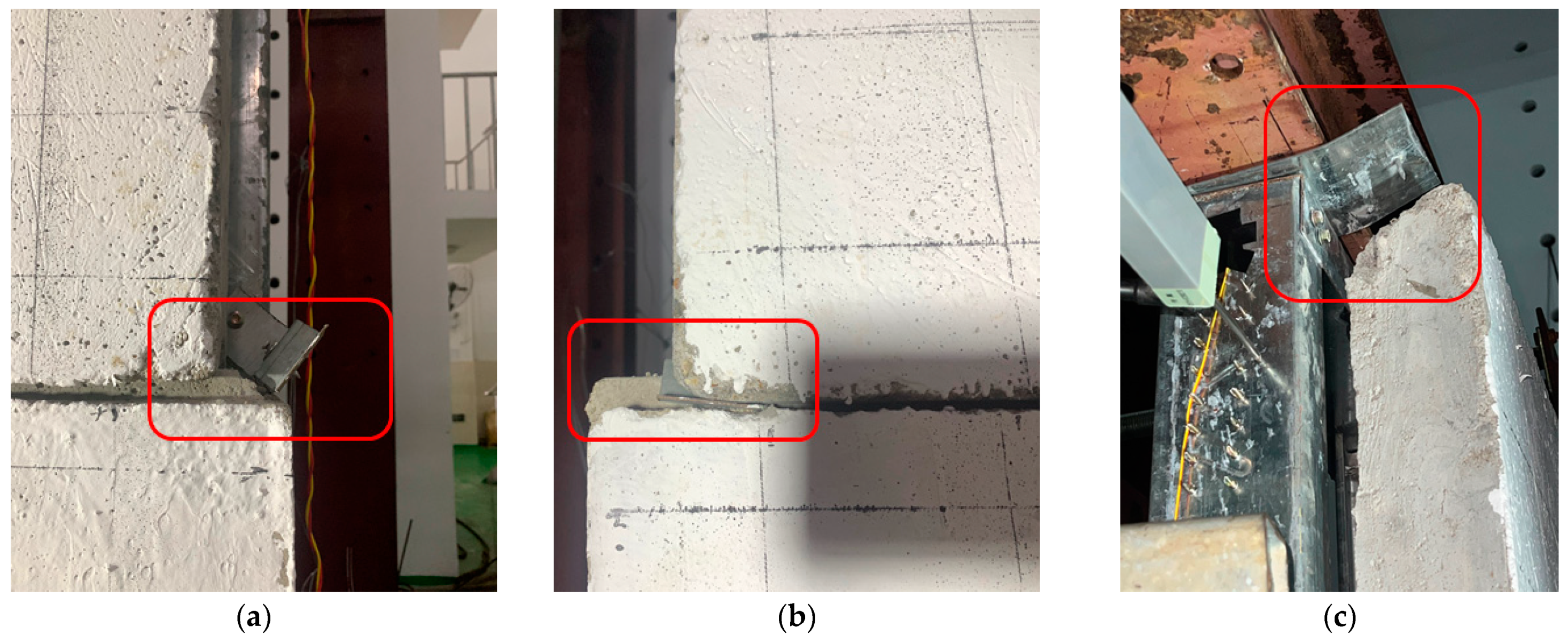

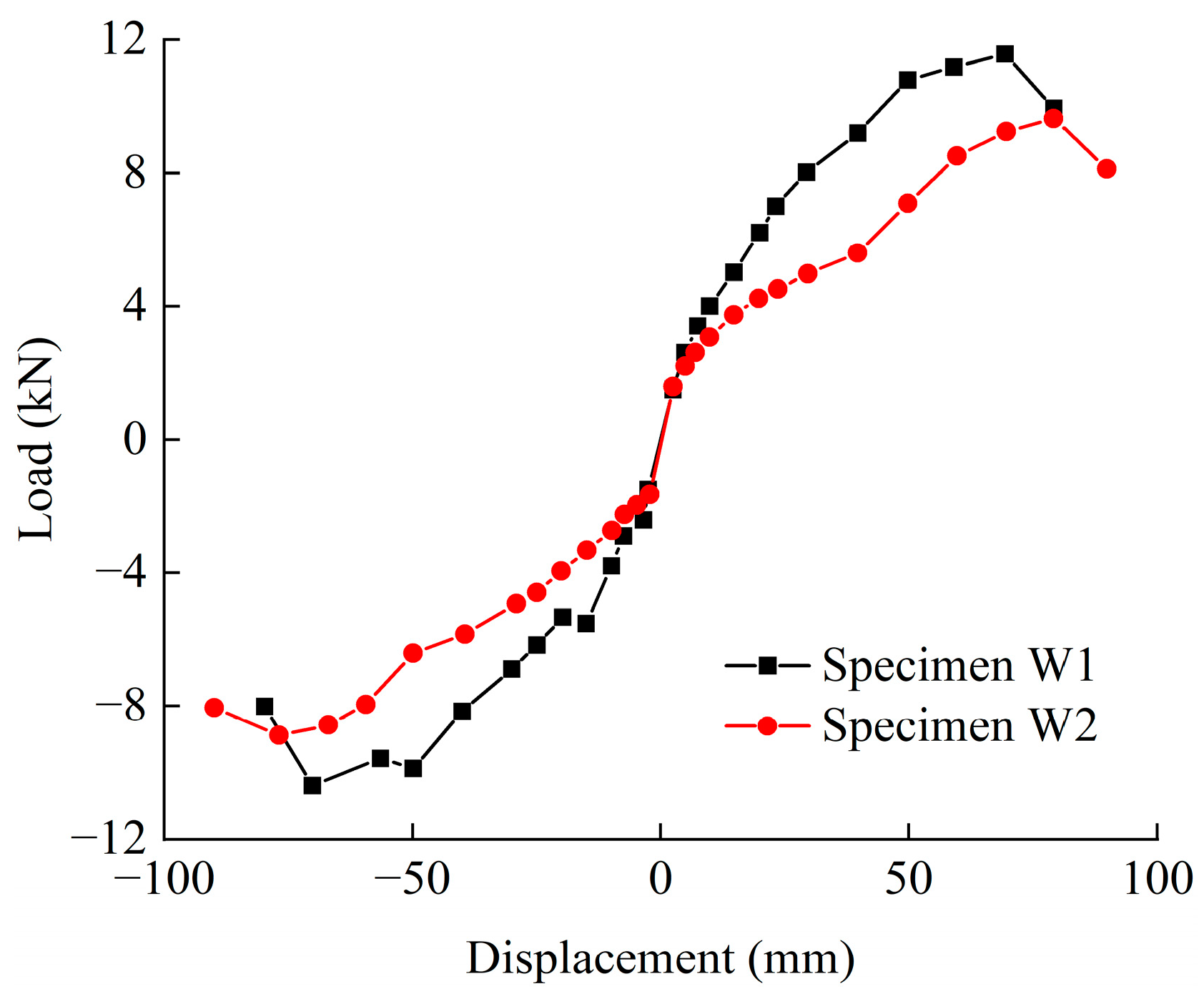
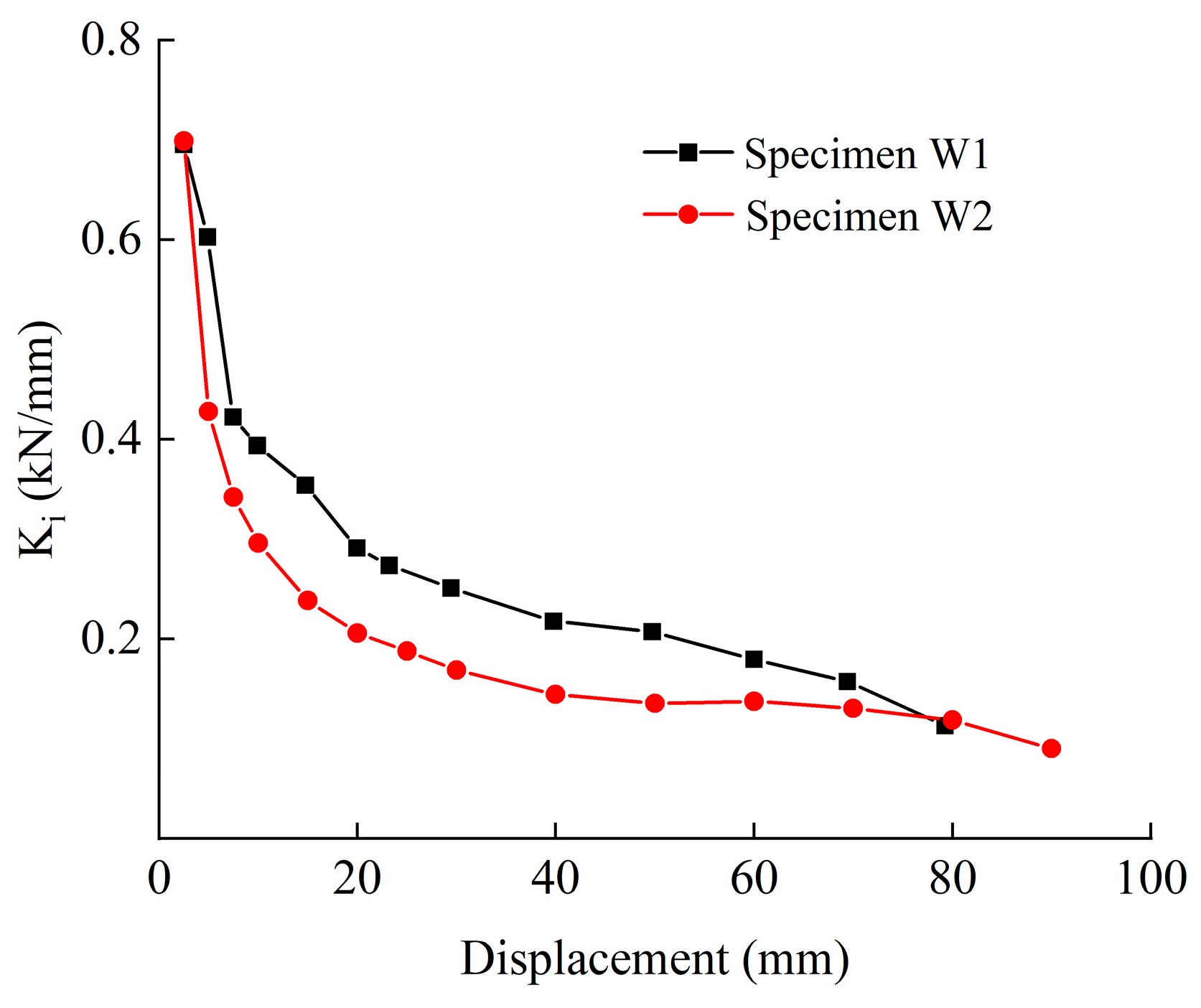
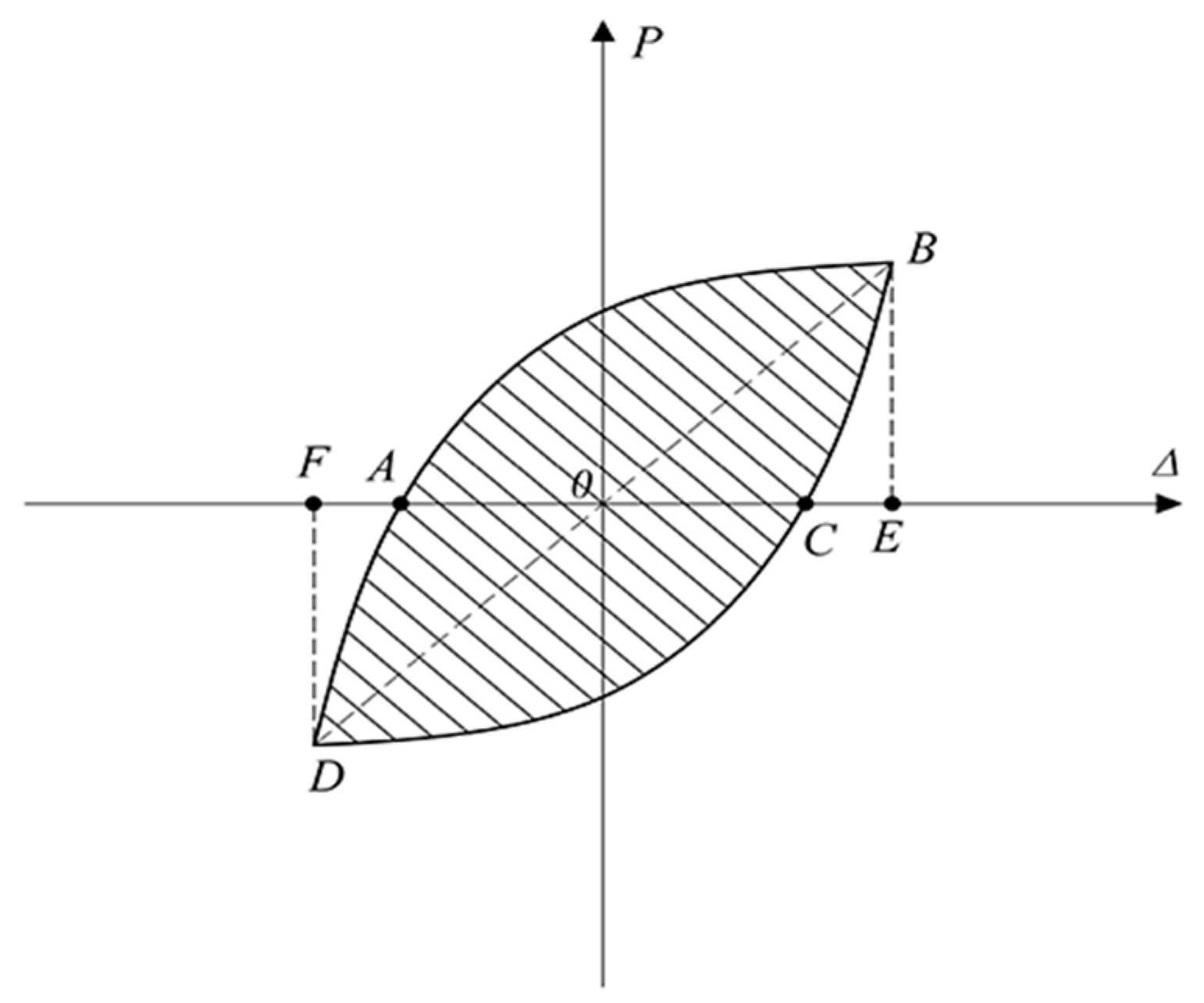
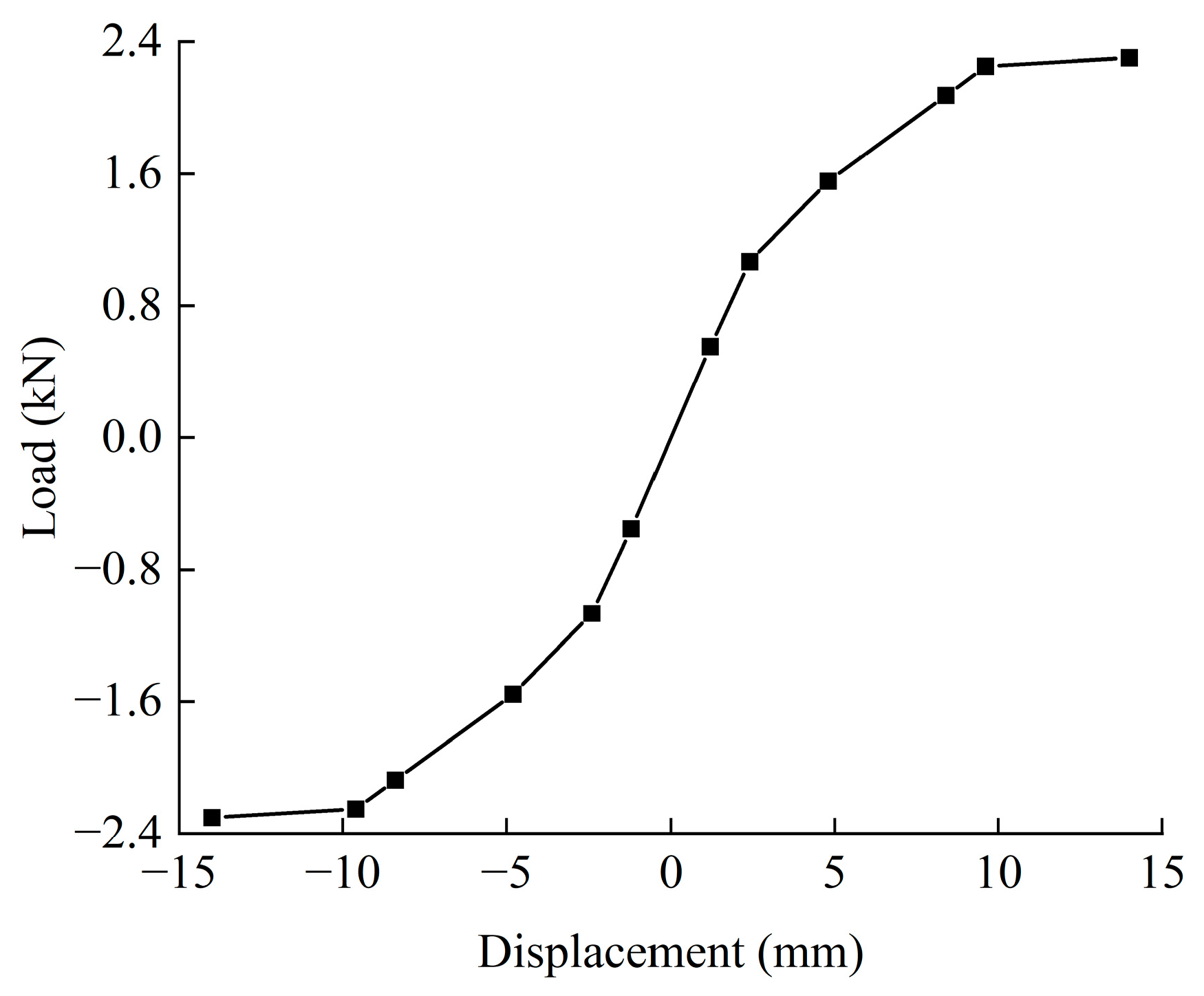
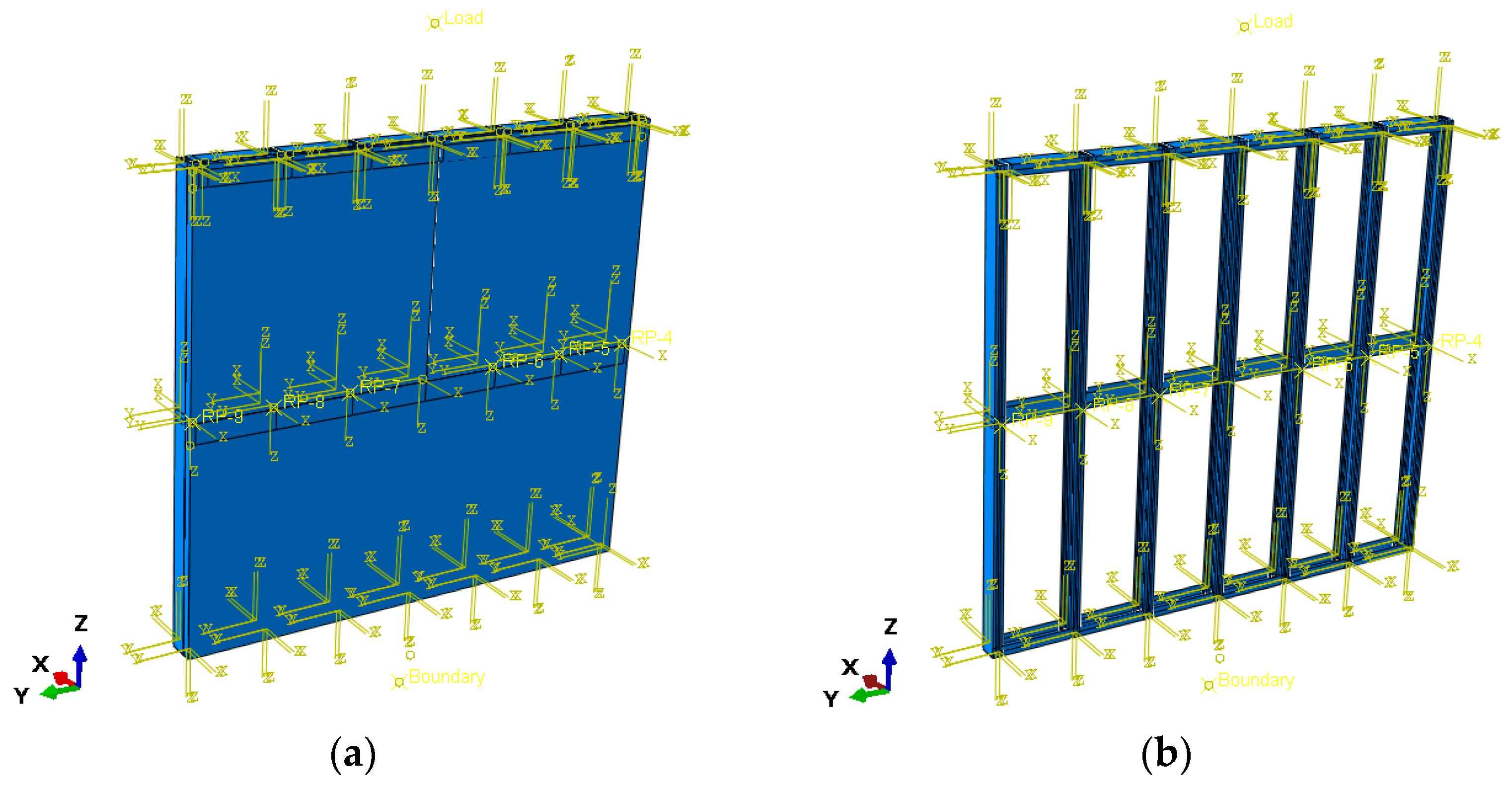
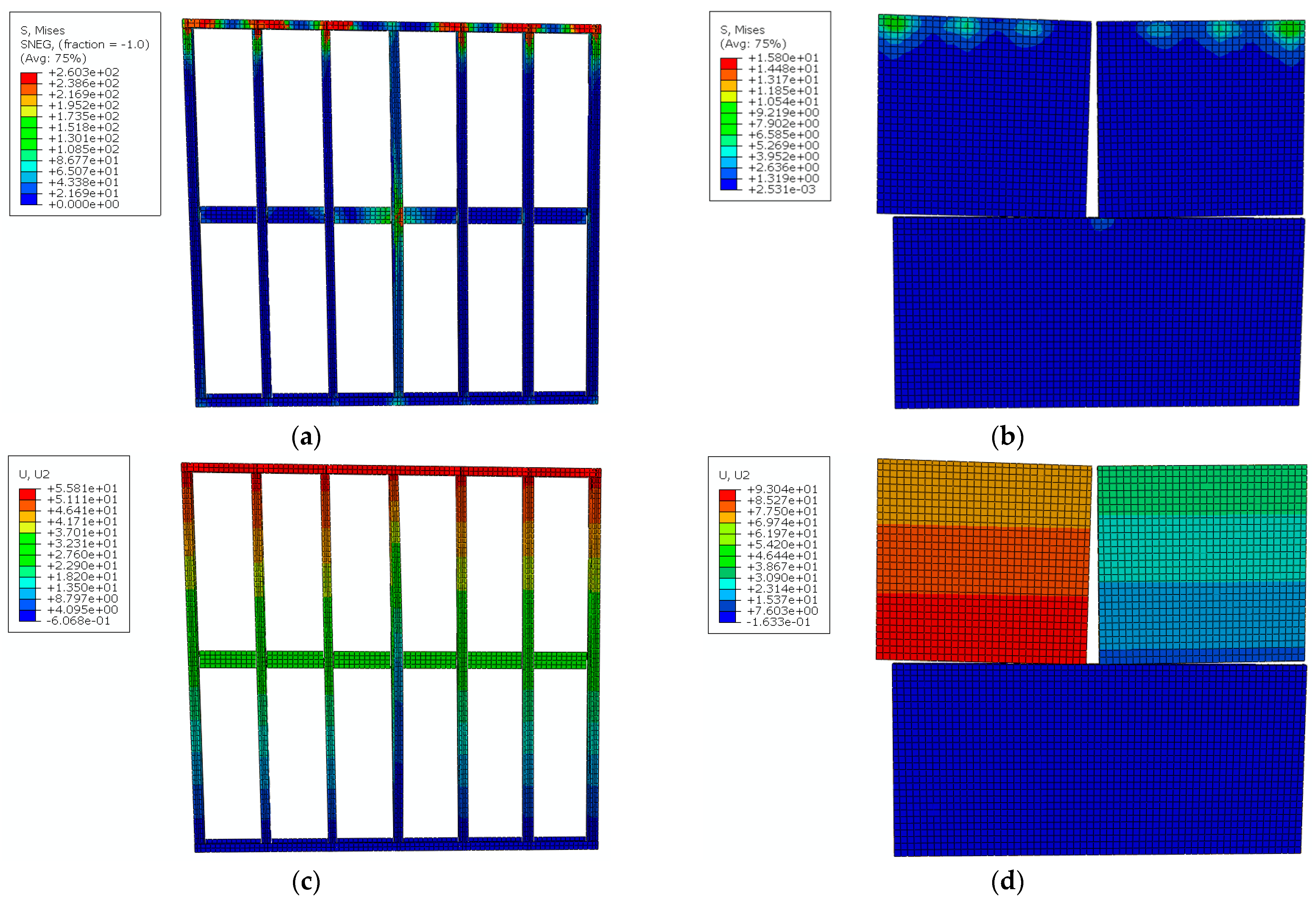
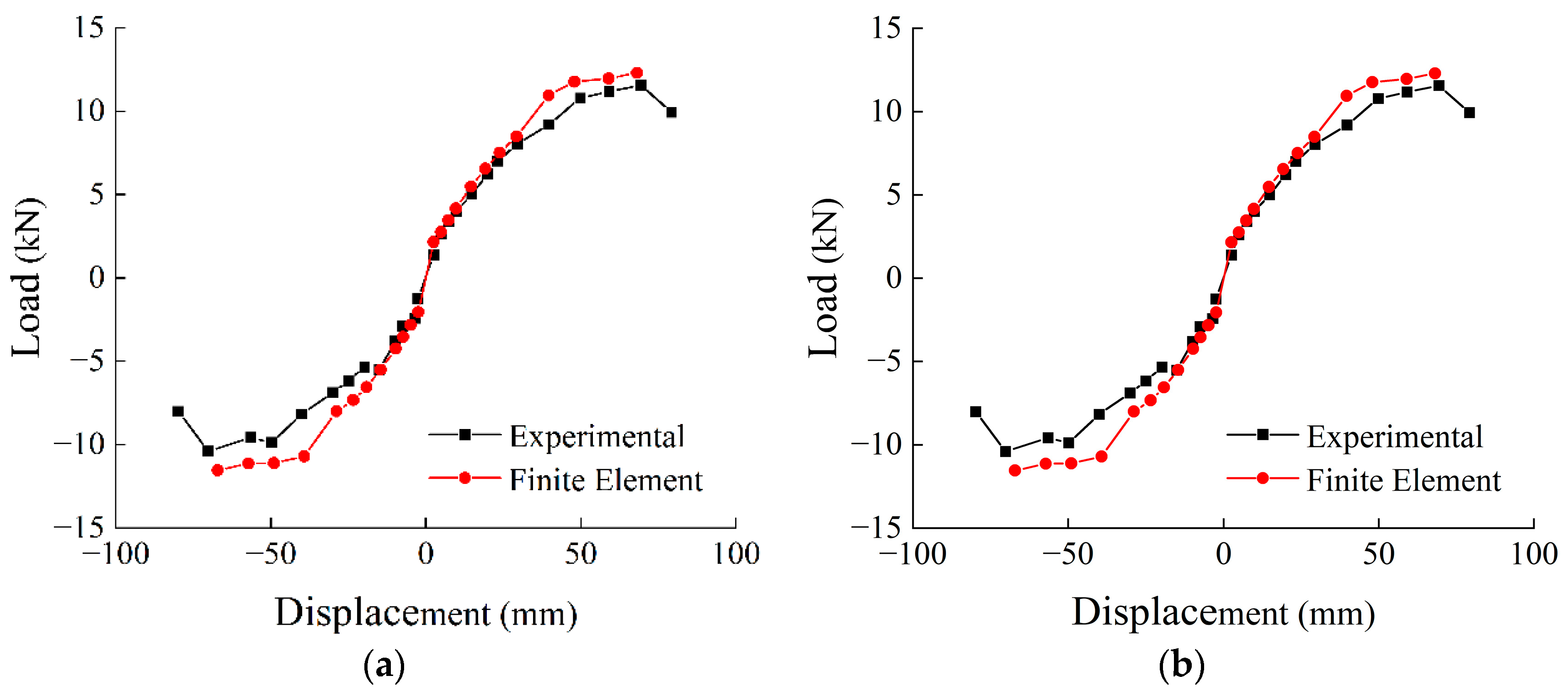
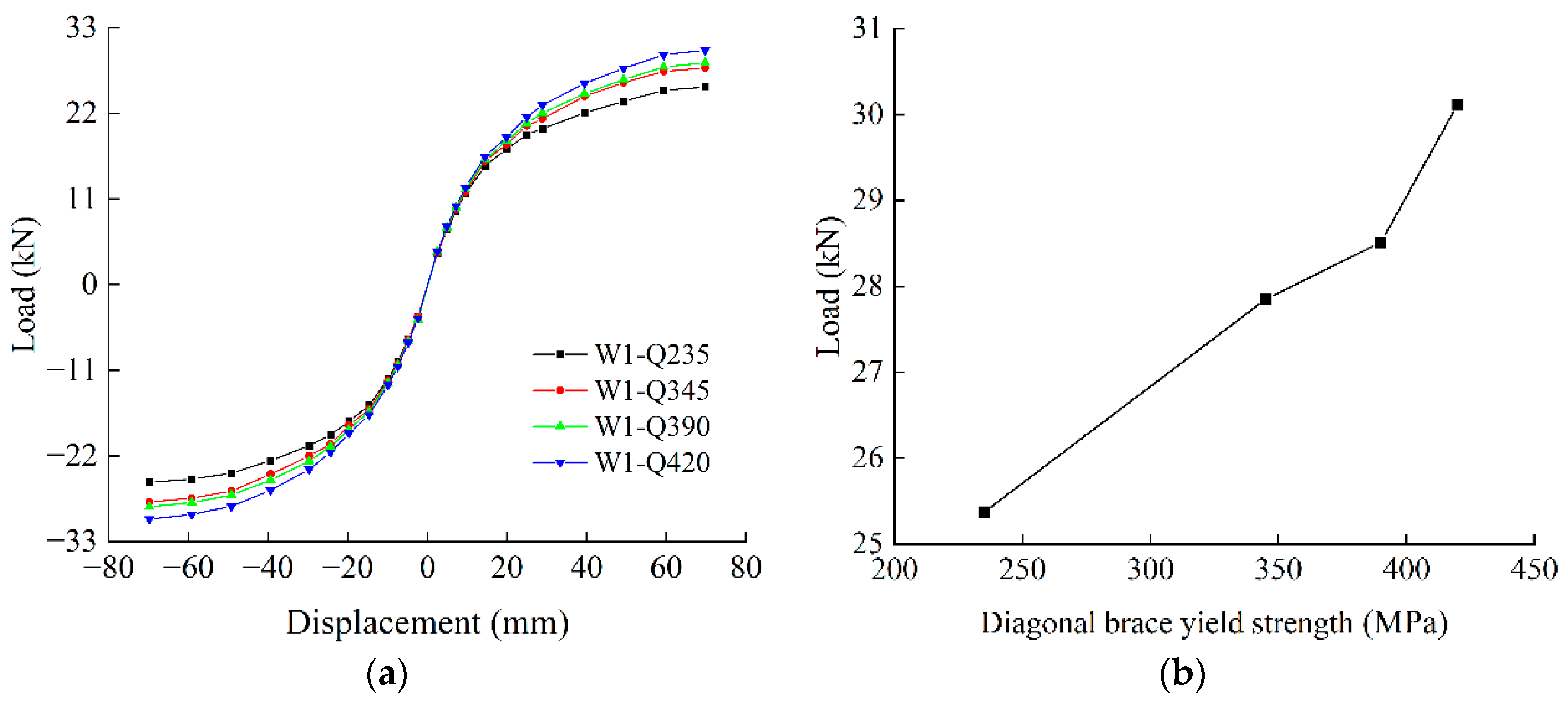
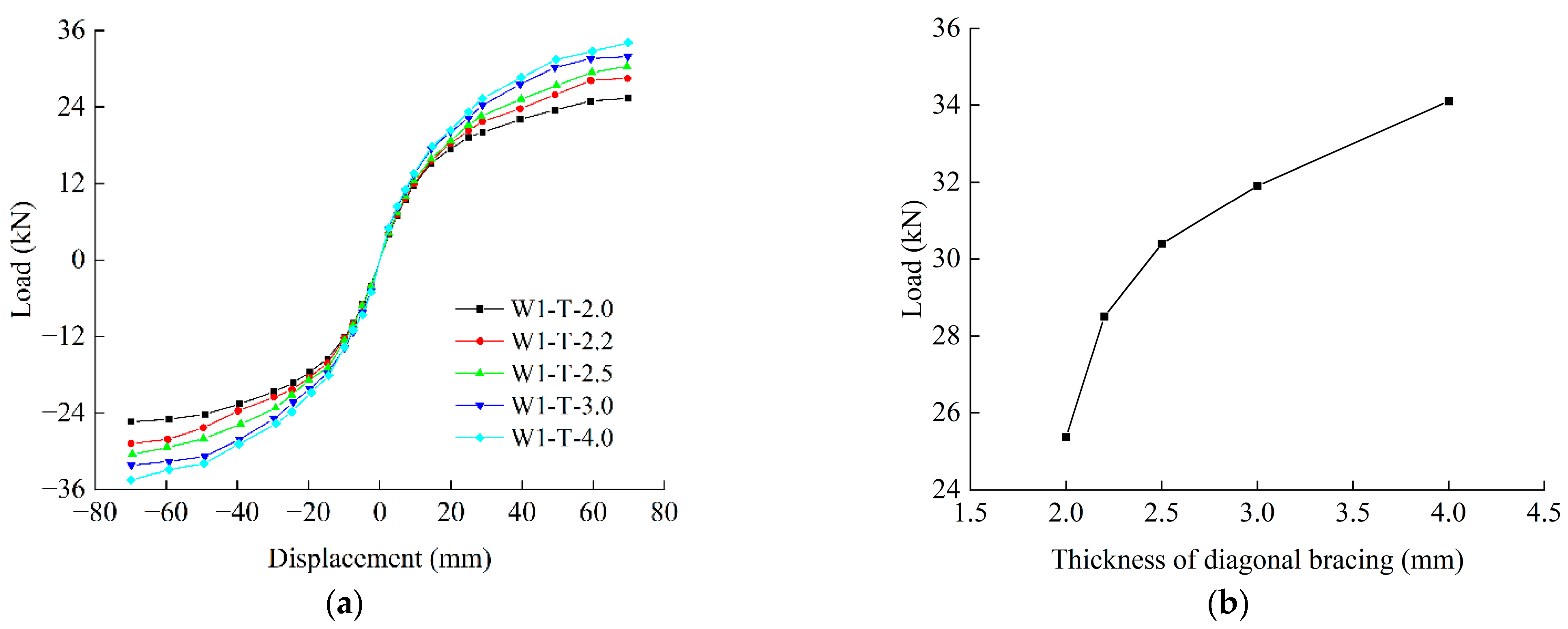
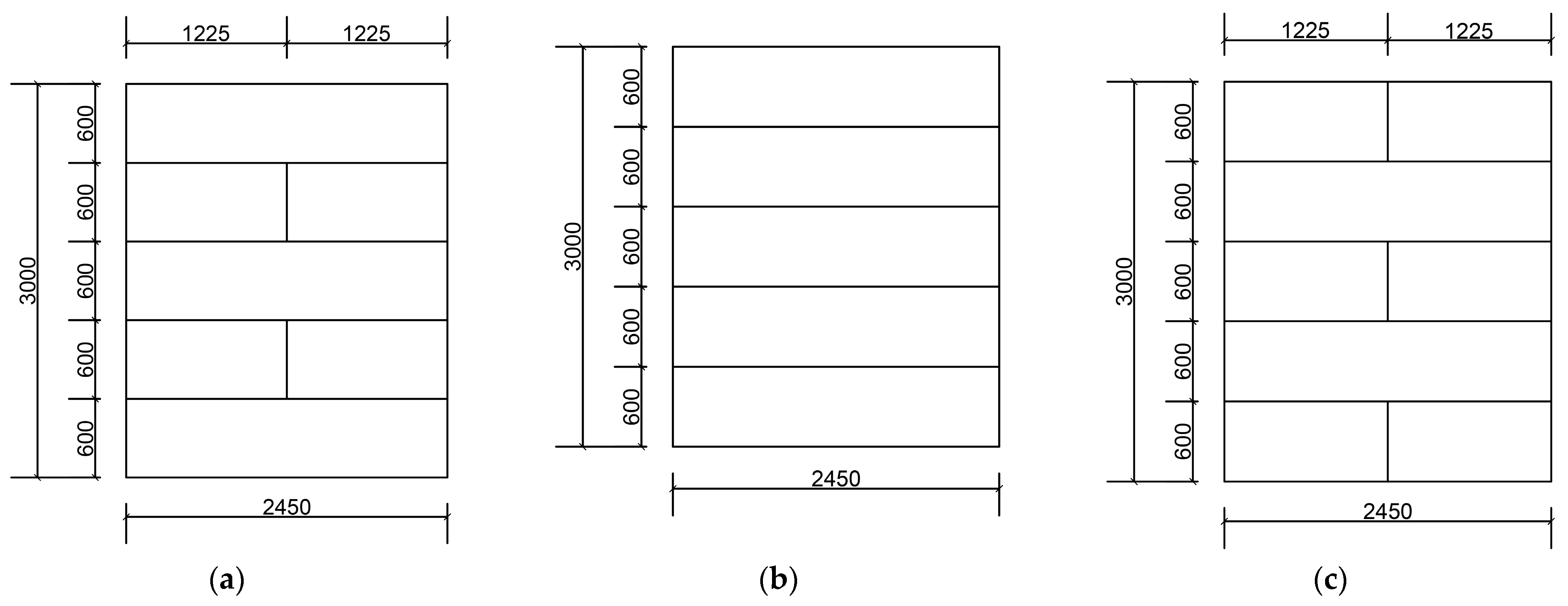
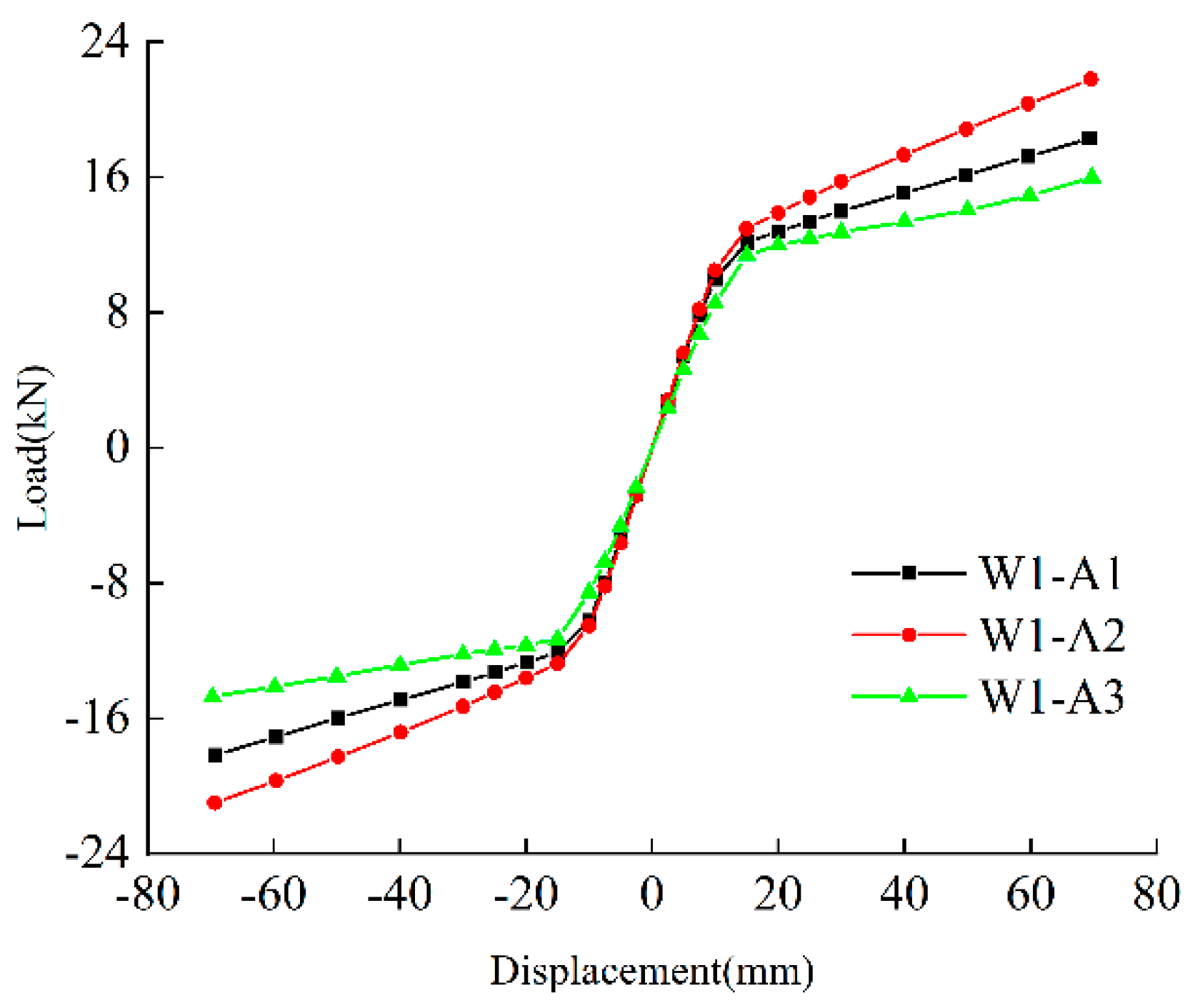

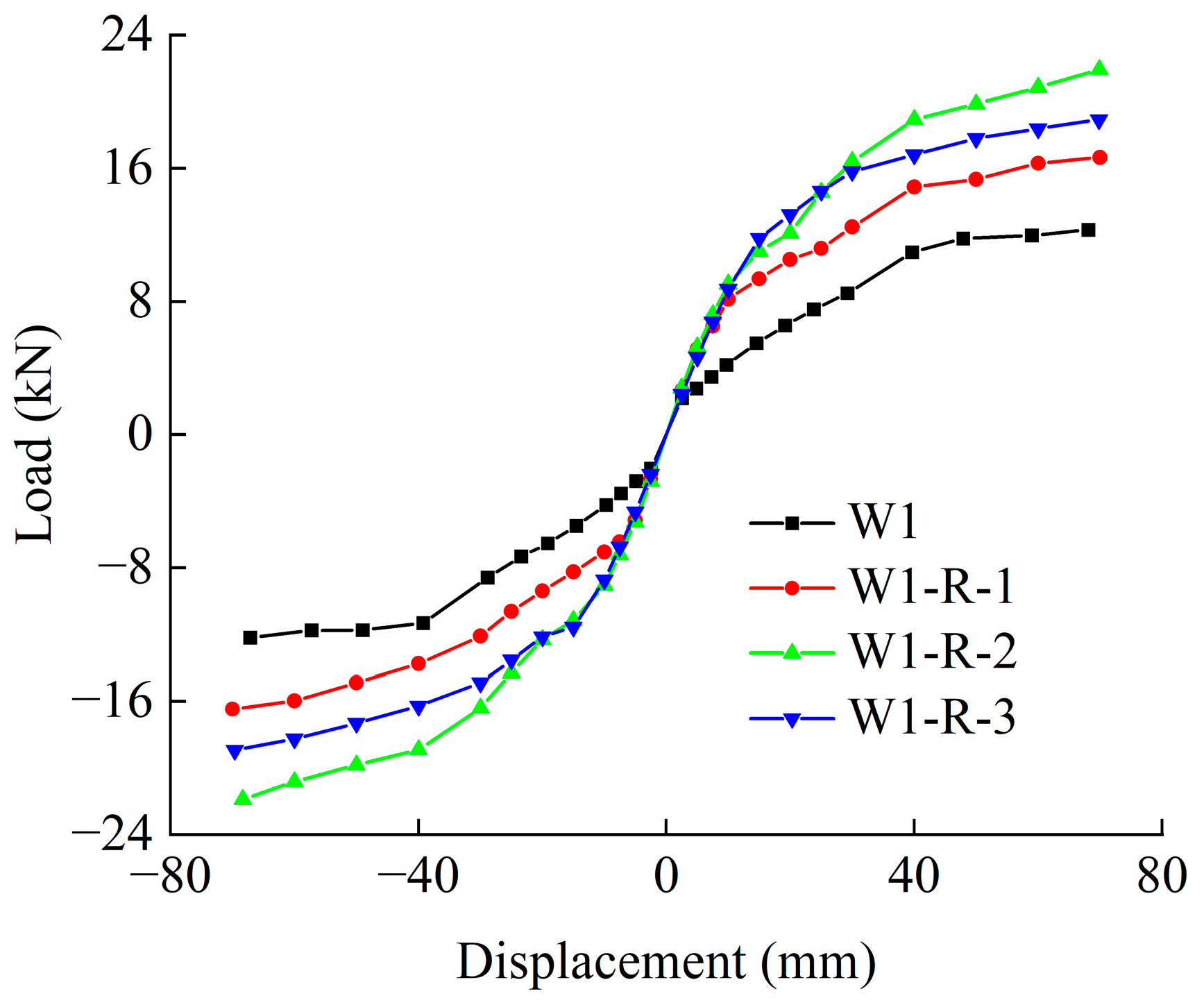
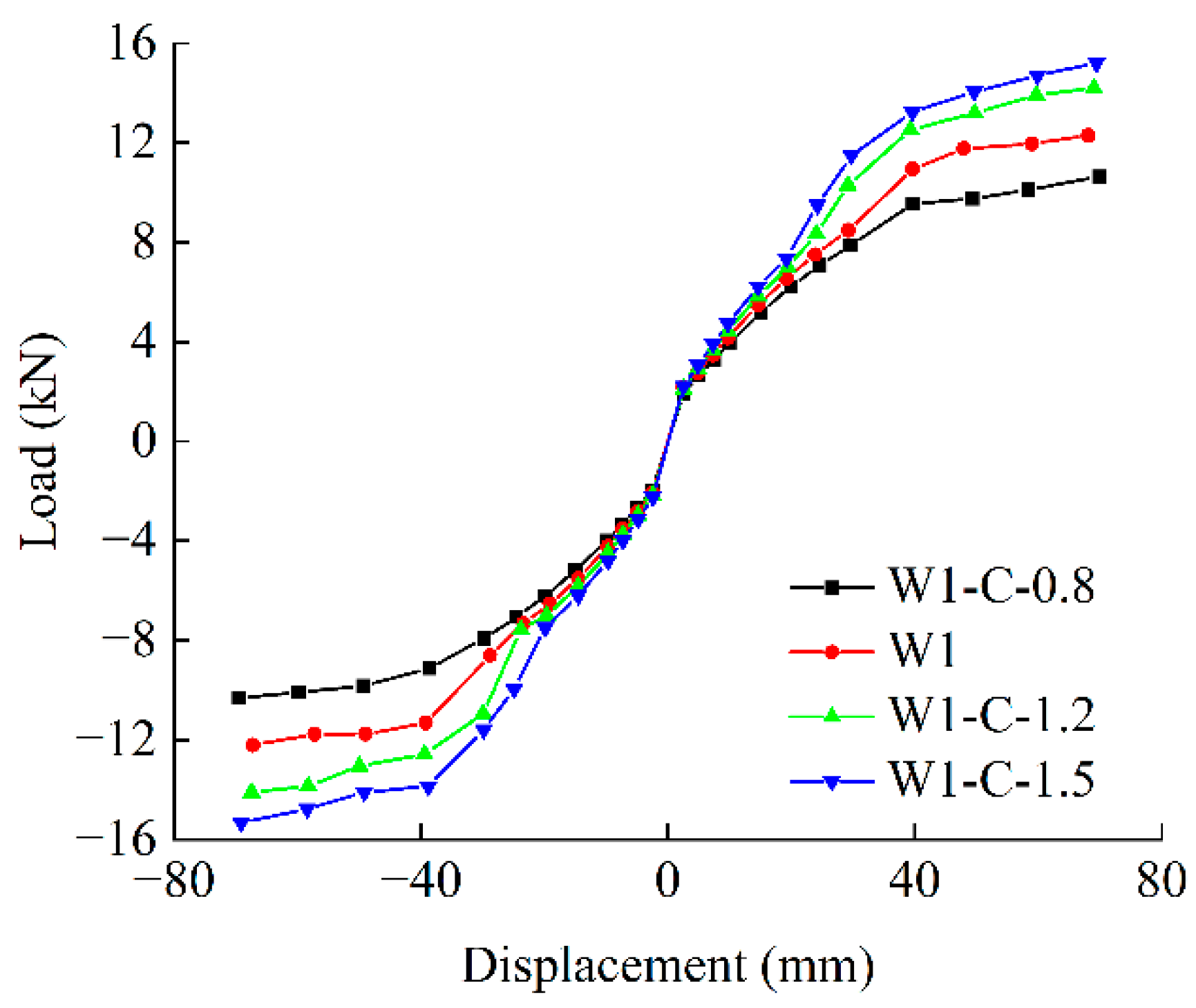
| Specimen Identification Numbers | Length/mm × Height/mm | Wall Panel Materials | Arrangement Pattern of the Wall Panels | Loading Method | Vertical Load |
|---|---|---|---|---|---|
| W1 | 2450 × 2300 | Precast concrete sandwich insulation wall panels |  | cyclic loading | - |
| W2 | 24,502 × 300 | Precast concrete sandwich insulation wall panels |  | cyclic loading | - |
| Specimen Identification Number | Yield Point | Peak Point | Ultimate Point | Lateral Stiffness | Ductility Coefficient | |||
|---|---|---|---|---|---|---|---|---|
(mm) | (mm) | (kN) | (mm) | (kN) | (mm) | K300 (kN/(m·rad)) | ||
| W1 | 9.79 | 43.5 | 11.57 | 68.62 | 9.94 | 79.20 | 424.01 | 1.82 |
| W2 | 8.56 | 59.98 | 9.63 | 79.22 | 8.20 | 89.66 | 336.73 | 1.49 |
| Specimen Identification Number | Energy Dissipation Coefficient at the Elastic Point E1 | Energy Dissipation Coefficient at the Yield Point E2 | Energy Dissipation Coefficient at the Peak Point E3 | Total Energy Dissipation Doefficient E |
|---|---|---|---|---|
| W1 | 1.36 | 0.82 | 0.71 | 1.24 |
| W2 | 1.32 | 0.71 | 0.68 | 1.06 |
| Parameter | Dilation Angle | Eccentricity | fb0/fc0 | K | Viscosity Parameter |
|---|---|---|---|---|---|
| Value | 40 | 0.1 | 1.16 | 0.667 | 0.0005 |
| Parameterized Analysis Object | Finite Element Model Identification Number | Diagonal Brace Yield Strength (MPa) | Thickness of Diagonal Bracing (mm) |
|---|---|---|---|
| W1 | W1-Q235 | 235 | 2.0 |
| W1-Q345 | 345 | 2.0 | |
| W1-Q390 | 390 | 2.0 | |
| W1-Q420 | 420 | 2.0 | |
| W1-T-2.0 | 235 | 2.0 | |
| W1-T-2.2 | 235 | 2.2 | |
| W1-T-2.5 | 235 | 2.5 | |
| W1-T-3.0 | 235 | 3.0 | |
| W1-T-4.0 | 235 | 4.0 |
| Finite ID | Dimensions of Wall Panels (Length/mm × Height/mm × Thickness/mm) | Number of Wall Panels | Number of L-Shaped Connectors |
|---|---|---|---|
| W1 | 2450 × 1150 × 50 | 1 | 7 |
| 1225 × 1150 × 50 | 2 | ||
| W1-R1 | 2450 × 800 × 50 | 1 | 13 |
| 1225 × 800 × 50 | 2 | ||
| 2450 × 700 × 50 | 1 | ||
| W1-R2 | 2450 × 600 × 50 | 2 | 20 |
| 1225 × 600 × 50 | 2 | ||
| 1225 × 500 × 50 | 2 | ||
| W1-R3 | 2450 × 450 × 50 | 2 | 26 |
| 1225 × 450 × 50 | 4 | ||
| 2450 × 500 × 50 | 1 |
Disclaimer/Publisher’s Note: The statements, opinions and data contained in all publications are solely those of the individual author(s) and contributor(s) and not of MDPI and/or the editor(s). MDPI and/or the editor(s) disclaim responsibility for any injury to people or property resulting from any ideas, methods, instructions or products referred to in the content. |
© 2024 by the authors. Licensee MDPI, Basel, Switzerland. This article is an open access article distributed under the terms and conditions of the Creative Commons Attribution (CC BY) license (https://creativecommons.org/licenses/by/4.0/).
Share and Cite
Zou, J.; Cao, B.; Zeng, X.; Zhang, Y. Lateral Performance of Composite Wall with Cold-Formed Thin-Walled Steel–Concrete Sandwich Panel. Buildings 2024, 14, 2928. https://doi.org/10.3390/buildings14092928
Zou J, Cao B, Zeng X, Zhang Y. Lateral Performance of Composite Wall with Cold-Formed Thin-Walled Steel–Concrete Sandwich Panel. Buildings. 2024; 14(9):2928. https://doi.org/10.3390/buildings14092928
Chicago/Turabian StyleZou, Jian, Baozhu Cao, Xiang Zeng, and Yuchuan Zhang. 2024. "Lateral Performance of Composite Wall with Cold-Formed Thin-Walled Steel–Concrete Sandwich Panel" Buildings 14, no. 9: 2928. https://doi.org/10.3390/buildings14092928
APA StyleZou, J., Cao, B., Zeng, X., & Zhang, Y. (2024). Lateral Performance of Composite Wall with Cold-Formed Thin-Walled Steel–Concrete Sandwich Panel. Buildings, 14(9), 2928. https://doi.org/10.3390/buildings14092928






